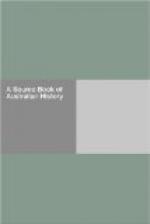basin of Port Lincoln, along the margin of the deep
water, consisting of 640 acres, divided into building
lots of one rood each, which will be enough for a
population of 50,000 persons, which is as many as
the most sanguine friend of the Colony can anticipate
for a century to come. There, under the shelter
of Boston Island, or in Spalding Cove, the merchant
may leave his office and walk across a plank into
the last ship that arrived from England, and all the
hundreds of bullocks now employed dragging up waggon
loads of rubbish and merchandise from Adelaide Swamp
to Adelaide Township, may then be dispensed with and
go a-ploughing, as they ought to have done long since,
which will save L20,000 a year to the settlers in the
item of land carriage alone, and by being employed
on the farms instead of on the road the Colony will
not require such frequent importations of farm produce
from Van Diemen’s Land, to the great impoverishment
of the community. What, abandon Adelaide!
I think I hear the carriers exclaim. Oh no, let
Adelaide remain as before, it will always answer well
enough for a country village, and stand a monument
to the folly of the projectors, but let the Governor
and Civil Establishment move their head-quarters without
loss of time, to Port Lincoln, before more money is
thrown away. Every month that this measure is
delayed it is made more difficult and therefore should
not be postponed at all. The buyers of the 1,200
town acres would feel much disappointment at the measure,
as the market would be spoiled for the sale of their
building lots, but they would be rightly served for
asking a monopoly price to respectable new-comers,
who ought to be enabled to obtain a town allotment
for a trifle of the Government.
In New South Wales they are sold by auction as applied
for, and put up at 20_s._ each, at which price they
are generally knocked down; but with a view to prevent
any monopolizer buying them up, to the injury of the
bona fide settler, every purchaser must sign
a bond to the Government in a penalty of L20, that
he will build a house on the allotment, of a certain
value, within three years, or otherwise the land reverts
absolutely to the Crown, and the penalty is enforced
too. This is as it should be, and the evil working
of the old system ought to have been forseen, but
at South Australia the Commissioners and Survey Department
disdained to copy anything from such a colony as Sydney
and made the old saying good about advice, that those
who want it most like it least. Now the late
Governor, Captain Hindmarsh, was quite the opposite
of this, and was most diligent in seeking out the
best way of doing everything, and was not above learning
even from those ignorant neighbours, New South Wales
and Van Diemen’s Land. Here is a proof.
(Copy)
“Government House, 25th April, 1838.
“The Council being about to meet this morning
to discuss a subject with which Mr. Horton James is
particularly well acquainted; the Governor will thank
Mr. James, if he would do him the favour to attend
the Council this morning about half-past nine o’clock,
to give the Council his opinion on the subject.




